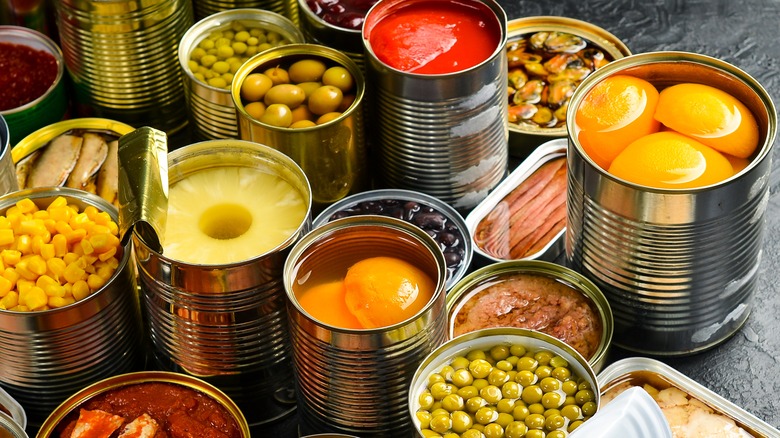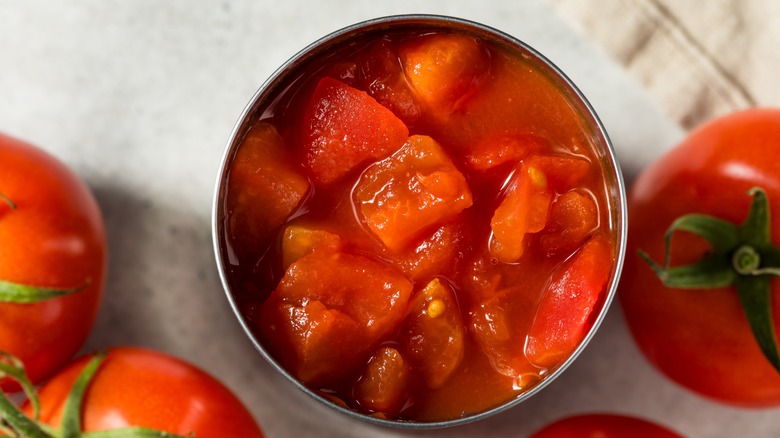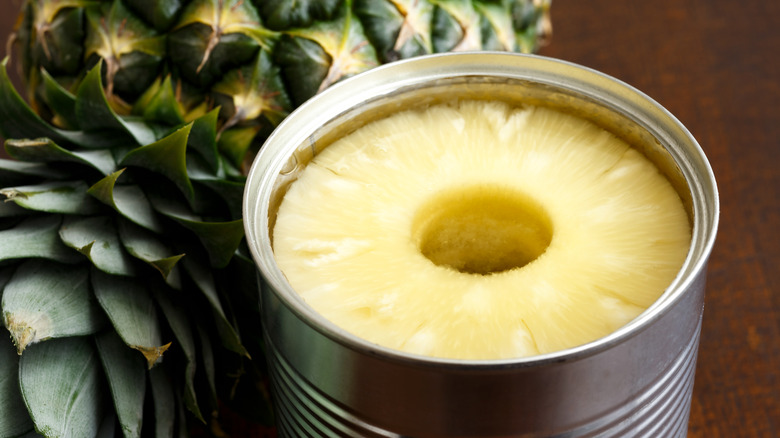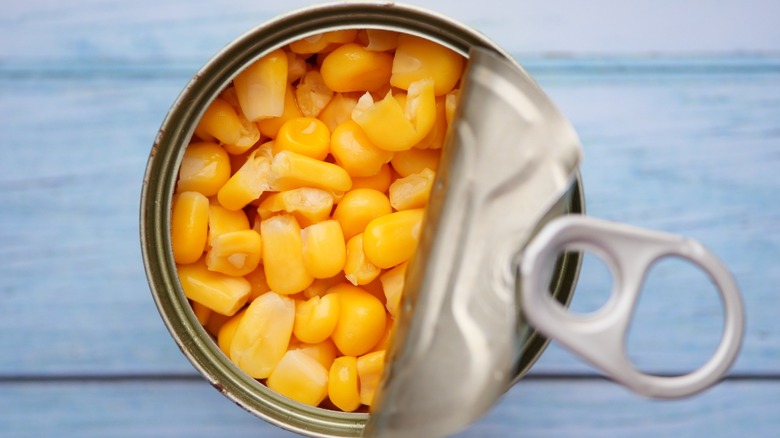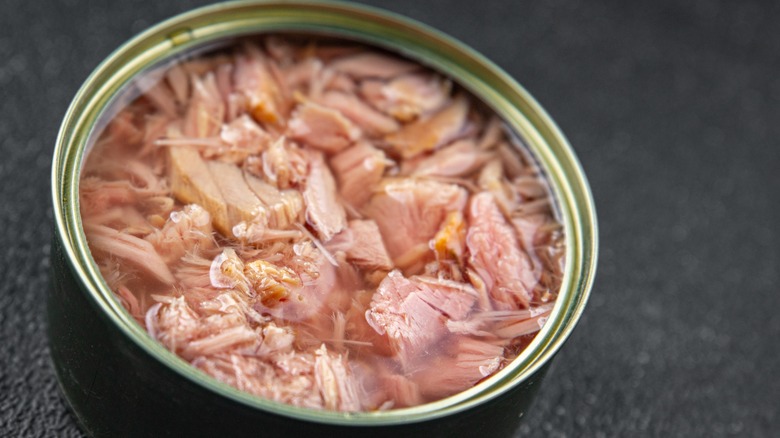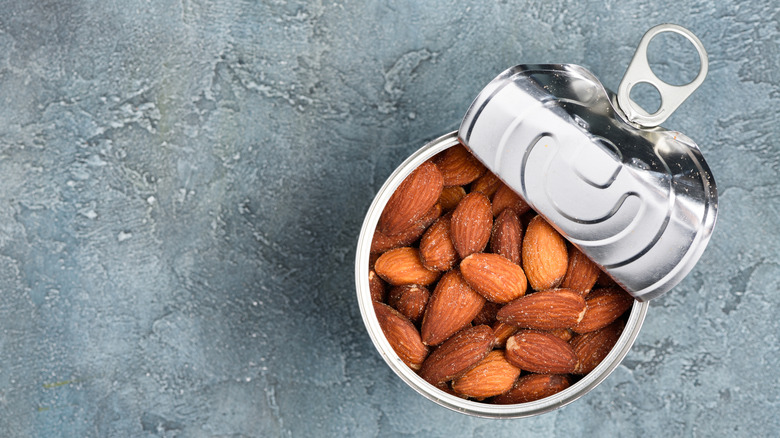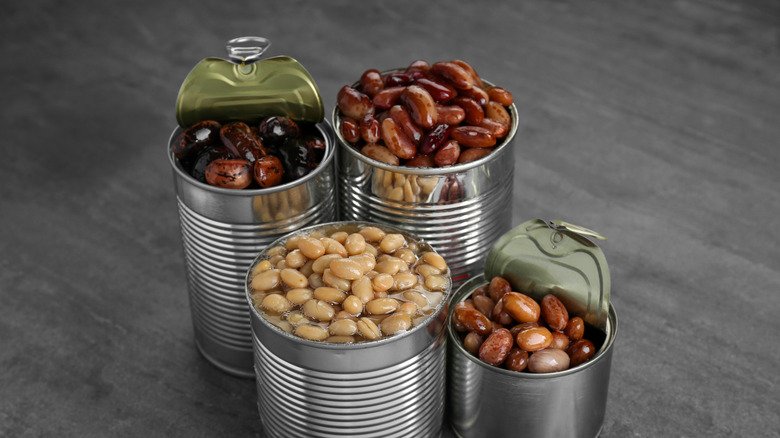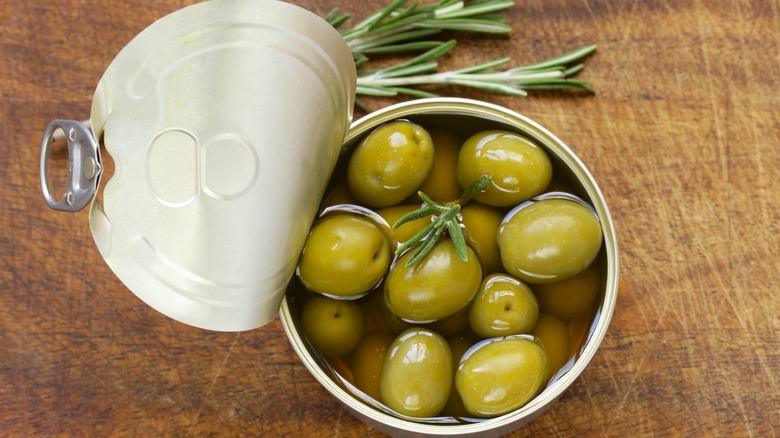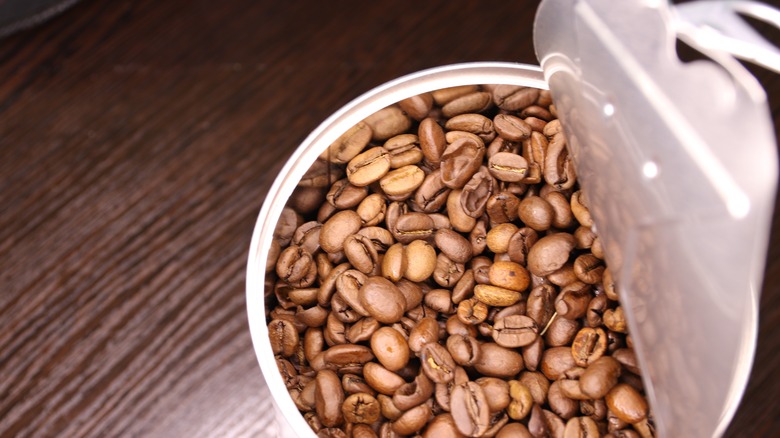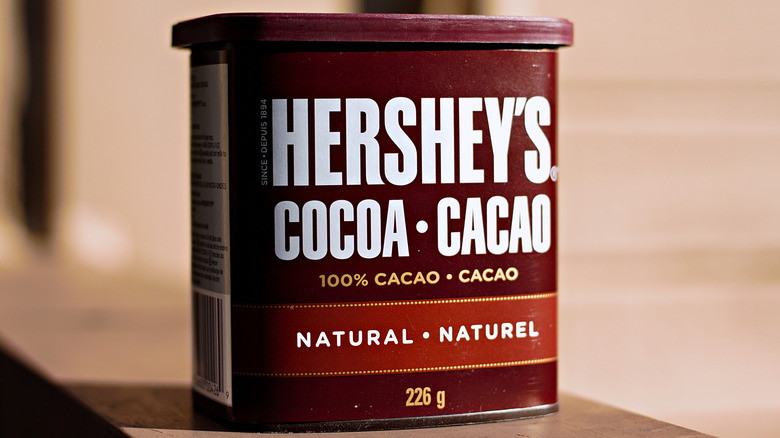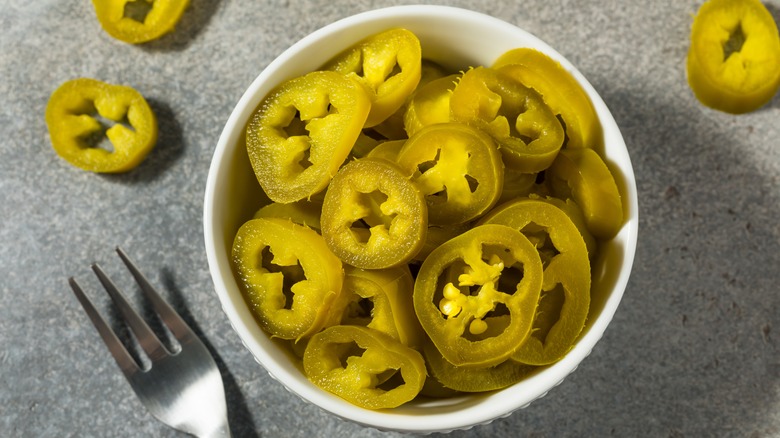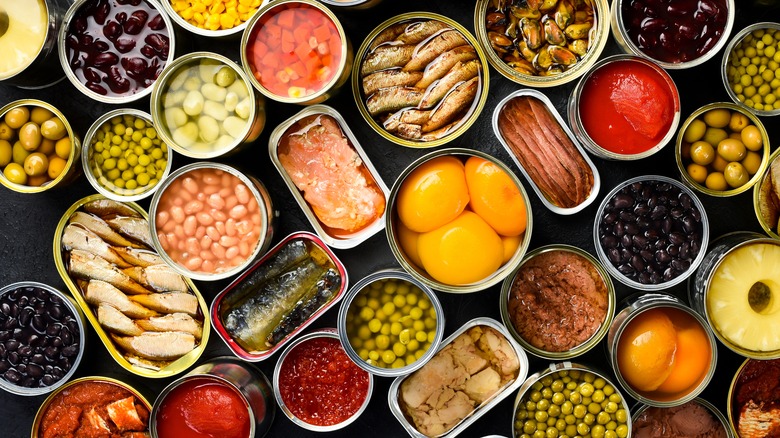Stock Up Now: 10 Canned Foods That Are About To Get More Expensive
Nearly every shopping sector is bracing for the potential price increases due to come with the current administrations tariffs taking effect. For grocery shoppers, this means not only elevated costs for produce and dry goods imported from Canada, Mexico and abroad, but also price increases on grocery store staples that utilize meat and produce from regions impacted by the additional tariffs. Beyond the added expense across the board for the steel used in making cans, your favorite pantry essentials — crucial food items featured regularly in your daily dining — stand a solid chance of becoming more costly in the near future.
Thankfully, the hold-off on implementing tariffs on nearly every country engaging in trade with the U.S. means you have time to get your canned food shopping strategy in the can. If you're in the habit of stocking your larder with a supply of canned goods, you may be interested to know which of these products are worth stocking up on before the price increases take place. Thanks to long shelf lives for most canned foods, you can easily grab extras while you still see prices you're used to. With everything from tuna to tomatoes on the line, these selections are prime picks for doing a bulk shop as soon as possible just to take advantage of what may soon be their lowest prices for the foreseeable future.
Tomatoes and Tomato Sauces
Whether you use them to make fresh salsa or brew them up into your nonna's classic spaghetti sauce, you should probably think about buying a supply of canned tomatoes before the shift occurs. Tomatoes may grow easily in the backyard gardens of the U.S., but grocery store tomatoes are frequently imported from countries like Mexico and Canada, to the tune of 99% of all tomatoes brought in during 2024. Currently, Mexico's tomatoes are due for a 20.91% tariff starting July 14 2025, while Canada's crops are slated for a 25% increase should the duties take effect in their current form. These popular fruits (or vegetables, if that's how you see them) could be one of the first casualties of the tariff wars.
How can you keep from getting smashed if tomato prices start to show wild growth? Find a shop that sells smaller cans of unseasoned sauce at lower prices and fill your cart for future meals. Not only will these be less expensive per piece than the larger cans, they'll also allow you to use only what you need without having leftovers to store or freeze, a practice which could end up costing you more. Remember to pick up a variety of canned tomatoes as well; varieties flavored with jalapeños and fire-roasted chilies could see extra price increases due to a double dose of tariff-sensitive produce packed inside.
Tropical Fruits and Juices
In 2024, the U.S. brought in 1.34 billion — with a b — kilos of pineapples from regions that include Mexico, Brazil, and Costa Rica, among others. So if you'd been thinking Hawaiian pineapples would be the salvation of your smoothie fix when tariffs finally fall into place, think again. Production in the states is actually projected to decline, and pineapple biggie Dole is already raising prices to cope with supply issues. Prices increasing even further due to limited domestic supply will add insult to injury for the additional cost of your canned pineapple or fruit cocktail blend on top of the new 10% to 25% tariffs. Mangoes imported from these same regions face the same duty-based increase, meaning a canned island mix may see compounding price increases.
And speaking of juicy, canned pineapple juice and tropical fruit nectars that utilize produce from distant lands — these will also likely be more expensive once the tariffs roll out. You'd be wise to get your canned collection sorted now and get ahead on your canned fruit situation so you don't get stung at the register once the new tariff structure is in motion. Obviously, it won't save you heartache when purchasing ripe and ready pineapples and other tropical produce. But at least you can breathe easily and enjoy the sweet bites you bought in advance.
Corn
Depending on what you read, you may hear that corn prices are due to drop in the U.S. thanks to a surplus from export reductions to China and Mexico, a major flip from peak export prices in 2024 for corn farmers. It's a logical conclusion, considering that farmers will be left with more corn than they can distribute and will likely be eager to offload it to producers who manufacture your favorite canned vegetables. But if you dig a little deeper, you'll discover that there's also word of a shift from corn to soybeans that could diminish corn growing in the states. Should this happen, imports will be required which will likely come from the countries where tariffs have been applied.
Even if corn supplies stay stable and farmers find themselves able to continue growing their crops, the fertilizer used is imported from Canada which means additional costs to growers for the supplies required. Add to all of this, a 10% tariff on corn crops leaving the U.S., and the possibility of a price hike for canned corn looms heavy in the distance. It might be best for you to grab some extra cans while prices are still predictable and relatively low. Your chain may even carry multipacks that can help reduce your costs even more. If you're a fan of creamed corn, consider adding this to your shopping list as well.
Seafood
You may take for granted that your tuna fish sandwiches will always be around the same price, considering that this popular canned meat is usually one of the more affordable items in the canned food section. But little of the tuna used by the major food canners of America actually comes from American fishermen. In fact, about 80% of all seafood consumed in the U.S. comes from imports, which puts your lunchtime tuna sandwich on the chopping block if and when tariffs finally take effect.
It isn't only canned tuna that will be impacted by the turning tide of the tariff. Other canned fish like salmon, anchovies and sardines are due to see their prices uplifted as well, as these products are also imported items. Should you use canned fish like these as staples in your daily eating habits, think about clearing off a little shelf space and stacking up additional purchases so you won't have to worry about it if and when the trade wars take the canned fish sector underwater.
Nuts
Thanks to retaliatory tariffs inching ever higher, that can of nuts that you snack on throughout the week may set you back up to 25% or more higher than what you're used to paying. A phase two list of items due to be hit with retaliatory tariffs from Canada include hazelnuts, almonds, pistachios, and walnuts. When similar items were caught up in a U.S.-imposed tariff stand-off in 2018, the tree nut industry saw losses upwards of $239 million. Who knows how high that number could climb this time. One thing is certain: It will be consumers covering the added costs when they head to the store for their favorite trail mix snack or bag of baking-ready nuts.
The upside may be that nuts are a frequent sale item in many of the largest grocery chains in the U.S. If you happen to see them on sale or you have a digital coupon through one of your shopping apps, you might want to take advantage and get them while they aren't at a premium. Better yet, head to your favorite warehouse outlet and invest in a bit of bulk product to make sure you have enough nuts to get you through this frosty pricing winter. Consider stashing them in the freezer so they last a little longer.
Beans
Many beans that end up as canned goods are grown around farms in the U.S., but not all of what you purchase is reliably American. Goya brand in particular imports around $30 million worth of agricultural product annually from Colombia, some of which ends up as the company's canned black beans and refried beans. Many imported black beans come from Brazil, too; both South American countries are facing a 10% tariff. With the additional costs being tacked onto the amount Goya pays, shoppers could experience a bit of shelf shock when the food producer rolls the price hike downhill and shopping for burrito night puts a dent in their canned bean purchases.
How can you work around the forthcoming price increases without blowing up your current shopping budget? It may seem like a good idea to buy the oversized cans of refried beans when you see them, but remember that once opened, the beans inside will be losing freshness unless you use them quickly, which defeats the purpose of stocking up. You're better off searching for sales on regular sized cans, projecting what you'll need for the next several months. Though there are many pros and cons to cooking with canned beans, it might be worth rounding up a nice little trove to keep Taco Tuesday and Tostada Thursday at your current standard without requiring a reverse mortgage to cover the bill.
Olives
The humble olive keeps a relatively low profile in the canned goods section, holding space for anyone assembling a charcuterie board or making cocktails for most of the year before making an auspicious return during the holidays. But as U.S.-sold olives are imported from Europe and Mexico, buyers should be aware that these savory stone fruits are subject to the unpleasant whims of tariff-based price increases. Black olives have already experienced a tariff-based price increase during the first Trump administration, during which a 35% increase occurred. Though the coming tariff would be smaller, it still stands to take a decent chunk out of your olive-buying budget.
Want to circumvent a cash flow issue before costs become the pits? If your Thanksgiving or Christmas spread just won't be the same without a bowl of black or green olives circulating around the table, consider doing your holiday food shopping a little early and stash a few jars and cans in the back of your cabinets now. The "best by" dates on these cans stretch pretty far into the future — up to two years for both jarred and canned olives if left unopened in your pantry — so you should have no problem with freshness or enjoyability, and you could be saving cash you'll need for gifts and stocking stuffers.
Coffee
Coffee is one of the most talked about victims of the tariff wars, with caffeine hounds eagerly watching to see when the ax falls. With coffee beans sold in the US grown in countries that face a 10% tariff — and in the extreme, a whopping 46% tariff for beans that come from Vietnam, which is the second-largest coffee producer on the planet — there's no real question that a price increase for your morning bean juice is destined to happen. The questions are when will it occur and how much more will you be willing to shell out for grounds and beans in your favorite canned coffee selections?
If you're a gourmet coffee aficionado, you may be used to buying your coffee in foil bags and may not even realize that less-bougie brands like Folgers and Taster's Choice still utilize cans for some of their pre-ground coffee offerings. The bad news here is that no matter what form you prefer, all coffee is in danger of becoming pricier. And if you're looking for a way to get ahead of the curve, buying larger cans could be a cheaper way to buy greater quantities to have on hand. Think about shopping for canned coffee to supplement your premium bean stock before prices climb into the clouds.
Cocoa
Cocoa is another imported item that shoppers take for granted; with beans grown largely in the southern hemisphere, it isn't until chocolate prices take a pogo stick jump that the public remembers the U.S.'s dependence on foreign trade to keep cocoa beans coming. It's bad enough that candy bars and ice cream are sure to be seeing a price leap due to the dastardly trade contest and a potential 10% tariff, but the unsweetened cocoa powder home cooks rely on for their finest baked goods is in jeopardy too.
Let's not forget the appearance of cocoa powder in other canned creations, namely hot chocolate mix. Nesquik and Ovaltine have made it easy for hot chocolate fans to mix up a batch of their favorite beverage whenever they want. But an increase of 10% on cocoa beans from Brazil and Ghana, 21% on Ivory Coast cocoa, 32% on beans from Indonesia and a staggering 46% on imports from Vietnam would inevitably be reflected in elevated prices on these household staples. If you're looking to invest your shopping money in ways that will insulate you from paying more down the line, make sure you pick up extra cocoa-based items to keep your life sweet before pricing becomes bitter.
Peppers
Anyone who can't even consider doing nacho night without a can of jalapeños to sprinkle on top would be wise to start a small collection to get the best deal possible. Canned jalapeños feature peppers brought to the U.S. directly from Mexico in larger quantities, due to recent reductions in domestic production. Though they come in relatively small packages, the potential for a large bump in costs could get shoppers hot under the collar. Red peppers are also brought in from Mexico, a leading source for U.S. imports and a soon-to-be target of tariff-based increases, which makes the canned and jarred forms vulnerable to price jumps.
Purposely picking up cans (and jars) of your favorite red peppers can ensure you have a steady supply without having to fork over more than you'd be happy to pay down the line. This version will last much longer than fresh peppers would while providing you the same vibrant ingredient for your homemade chili and robust sauces you're used to. Roasted red peppers in oil may seem like a luxury at the moment, but if you have a taste for them, get them now before the numbers roll even higher and the luxury status makes them too precious to afford.
How I chose these foods
With the stop and start nature of tariffs on international trade and the escalating response from so many countries the U.S. relies on for food imports, it's a definite challenge to determine which canned foods will be impacted most and which may slide by without too much damage. Though increases in steel prices could affect all canned products across the board, the foods on this list stand the highest chance of price elevation due to their trade-dependent nature. The obvious initial choices were items imported into the U.S., which leaves little question that these items will be impacted at some point. The amount of the tariffs that ultimately cause the price increases remains to be seen, as do the increases themselves; depending on what happens between now and when the full effect is felt, rising prices could be modest or monumental.
But beyond increases for produce and meat that goes in the cans, U.S. farmers who grow many crops used in domestic canned foods will also encounter increases for necessities such as equipment and machinery, fertilizer, and basic infrastructure manufactured outside the U.S. Farmers who pay more to farm but end up seeing reduced sales are likely to increase their prices just to keep their operations afloat. Once this happens, customers will likely end up paying higher prices to cover costs assumed by food producers consuming the additional expense charged by their growers.
